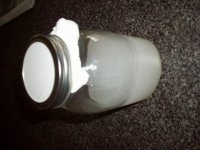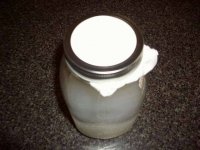Lacto Bacilli: process and discussion
- Thread starter Thread starter jaykush
- Start date Start date
J
JackTheGrower
strainbrain, that is consistent with many experiences using lacto b, and also formulations like EM.
the EM people claim it breaks down lignin, but that does not explain why it brings soil back to life.
I am thinking it must feed the soil bacteria (or make food in the soil digestible) in a big way for a limited time before dying off. basically probiotics for soil.
just speculating.
Lignin
I didn't remember/know what that was.
S
spiral
Effective microorganisms or EM is a mixed culture of beneficial microorganisms, primarily photosynthetic bacteria and Lactic acid bacteria, yeast, actinomyces, and fermenting fungi, that can be applied as an inoculant to increase the microbial diversity of soils.
Got that quote from here http://www.agriton.nl/apnanman.html
very good information here. You can buy the stuff online, try googling EM.
Got that quote from here http://www.agriton.nl/apnanman.html
very good information here. You can buy the stuff online, try googling EM.
how come the liquids are not in equal amounts?
Because I don't need a lot and it's a pain to slow bubble such a small amount. This isn't a race I'm just learning more is all.
BTW that's a maintained 70F and in the dark.
This has all been very informative. I'm grateful for the collective knowledge.
Funny you should say that. The bubbles offer agitation, and I wondered if her results were from aeration, agitation or both.
I don't have a magnetic stirrer.
I'm not getting the big sticky foam that I expected. I did initially and thought I was off to the races. But then no more foam last night. Today just little bubbles from air hose.
I'm confounded.
I don't have a magnetic stirrer.
I'm not getting the big sticky foam that I expected. I did initially and thought I was off to the races. But then no more foam last night. Today just little bubbles from air hose.
I'm confounded.
GeneticHeirloom
Member
Well I dove in and started my Culture.
After 24 hours of settling, the rice bran wash has floated to the bottom instead of to the top like mentioned in the original instructions. Does this bran at the bottom turn upwards in the next couple of days or is there no bacteria in there and I need to re-do it?
After 24 hours of settling, the rice bran wash has floated to the bottom instead of to the top like mentioned in the original instructions. Does this bran at the bottom turn upwards in the next couple of days or is there no bacteria in there and I need to re-do it?
After 24 hours of settling, the rice bran wash has floated to the bottom instead of to the top like mentioned in the original instructions. Does this bran at the bottom turn upwards in the next couple of days or is there no bacteria in there and I need to re-do it?
let it sit at least another day the collection period is important imo. the stuff goes up sometimes, sometimes down. no need to start over, remember your collecting all kinds of microbes at this point not just lacto bacillus. and everyone will culture different microbes with the rice wash!!!!!! just be patient, after a few times you'll have the process down no problem. it seems complicated, but the lacto b culture is by far one of the easiest, cheapest, and laziest things i can make. i love to dump loads of it on my compost, and spray my chicken pen ( works WONDERS ), and foliar spray, and soil drench, and well...you get my point.
in fact i think i might start a batch right now
Jaykush. Always at the ready to help. Very cool of you.
After an air sample is introduced you put the lid on (loosely), right? No more active collection from air?
Looking at your comment: "remember your collecting all kinds of microbes at this point not just lacto bacillus" That sounds like the lid is off.
Thanks for clarifying.
After an air sample is introduced you put the lid on (loosely), right? No more active collection from air?
Looking at your comment: "remember your collecting all kinds of microbes at this point not just lacto bacillus" That sounds like the lid is off.
Thanks for clarifying.
Looking at your comment: "remember your collecting all kinds of microbes at this point not just lacto bacillus" That sounds like the lid is off.
the lid can be off it can be slightly covered and it can be loose. ive done them all and ended up with the same results. now i don't even pay attention when i make it, its just second nature now. so i cant say which i actually do.
YES you are culturing more than lacto B. the air around you is FULL of micro organisms and spores and all kinds of stuff. when you give them a food source, which is the rice wash. they transfer from the air to the wash and consume and multiply, then you add milk and from what i can get from the original article, the milk and the lactic acid in the milk select and favor the lacto bacillus ( lactic acid bacteria ) and so on.....
i have even added molasses to the colonized rice wash, let it sit a few days. then diluted and applied that and skipping the milk all together. i consider it a liquid form of BIM (beneficial indigenous microorganisms) but i still recommend anyone to do the simple instructions first. to get that down and THEN tinker with it to your wildest desires. this way you have something to base all your tinkering on.
GeneticHeirloom
Member
let it sit at least another day the collection period is important imo. the stuff goes up sometimes, sometimes down. no need to start over, remember your collecting all kinds of microbes at this point not just lacto bacillus. and everyone will culture different microbes with the rice wash!!!!!! just be patient, after a few times you'll have the process down no problem. it seems complicated, but the lacto b culture is by far one of the easiest, cheapest, and laziest things i can make. i love to dump loads of it on my compost, and spray my chicken pen ( works WONDERS ), and foliar spray, and soil drench, and well...you get my point.
in fact i think i might start a batch right now
Awesome, thank you yet again for clarification!
I think I might have found a trick to having a proper lid on the jar that allows air to travel through it.... 5-8 pieces of kleenex tissue then I used the screw on piece of the mason jar to make the kleenex stretch and go perfectly straight to form a porous lid.. just don't tip it over or shake it lol.
I'll let you know if it works, i've had the mixture settling for 24 hours now.
GeneticHeirloom
Member
http://www.infrc.or.jp/english/KNF_Data_Base_Web/PDF KNF Conf Data/C4-9-154.pdf
EM which in these tests had superior performance was formed anaerobically while the other inoculates with less performance were formed aerobically. Looking at the Lactobacilli plantarum though it doesn't use oxygen it does respire it and it ends up as H2O2 and as per Spiral's quote kills the other beneficials.
EM which in these tests had superior performance was formed anaerobically while the other inoculates with less performance were formed aerobically. Looking at the Lactobacilli plantarum though it doesn't use oxygen it does respire it and it ends up as H2O2 and as per Spiral's quote kills the other beneficials.
A couple of quick tips:
a) When fermenting LAB 'pure culture' into LAB 'serum'* add a 0.5-1 inch layer of mineral oil to keep it anaerobic...it's the way to go! b) And as LAB are "mesophilic" microbes, keeping the solution temp while fermenting around 100F is very wise. I apologize if these tips have already been mentioned. I have no yet had the time to read this whole thread.
*Gil Cardang's (sp?) terms, or do I have the terms backwards? lol
Shalom
Ps. I have written much about bokashi, and it's Western equivalent "silage" in the last few pages (8-10) of the thread "mycorrhizae and organics...". Also, I wrote much about fermenting EM to AEM and LAB pure culture into LAB serum on those same pages. IMO it's worth reading
a) When fermenting LAB 'pure culture' into LAB 'serum'* add a 0.5-1 inch layer of mineral oil to keep it anaerobic...it's the way to go! b) And as LAB are "mesophilic" microbes, keeping the solution temp while fermenting around 100F is very wise. I apologize if these tips have already been mentioned. I have no yet had the time to read this whole thread.
*Gil Cardang's (sp?) terms, or do I have the terms backwards? lol
Shalom
Ps. I have written much about bokashi, and it's Western equivalent "silage" in the last few pages (8-10) of the thread "mycorrhizae and organics...". Also, I wrote much about fermenting EM to AEM and LAB pure culture into LAB serum on those same pages. IMO it's worth reading
Latest posts
-
My experience: Why I stopped mixing cannabis with tobacco
- Latest: VerdantGreen
-
-
Latest posts
-
My experience: Why I stopped mixing cannabis with tobacco
- Latest: VerdantGreen
-
-





